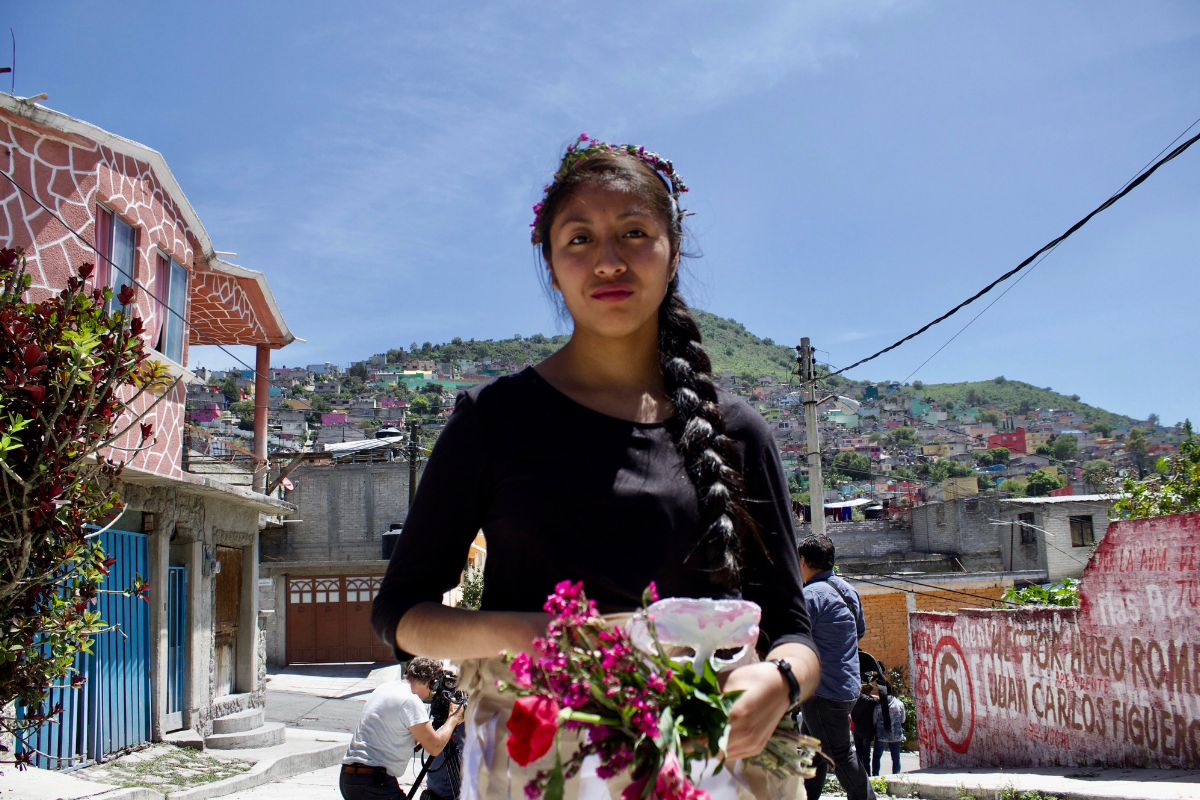

Carolina Aguilar Navarrete during a Invisibles Somos Visibles (Invisibles We are Visible) performance in Colonia Ostor, Ecatepec. Invisibles Somos Visibles is a collective that uses performance art to denounce femicide. (Photo by Nidia Bautista/Latino USA/NACLA).
This piece was published as part of a collaboration between Futuro Media Group’s Latino USA and NACLA.
ECATEPEC, MEXICO — Viviana Muciño climbs out of her black Saturn in the parking lot of Ecatepec’s Women’s Justice Center, a building perched on a hill overlooking a vast array of multi-colored concrete homes etched into green mountains. Muciño works as a volunteer assisting women who have experienced gender violence in Ecatepec and their families. Ecatepec is a city of sprawling slums that’s the ninth largest in North America, once considered the femicide capital of Mexico, and still holding one of the highest femicide rates in the country.
Muciño is an expert in Mexican law and gender crimes. Over and over again, she tells relatives of women murder victims to ensure that no one tamper with crime scenes and that forensic experts take all the appropriate photos. It is also essential that the public prosecutor documents and collects all of the evidence for the investigation file, she stresses. If public officials don’t do it, she teaches relatives how.
Muciño doesn’t have a law school education. She became an expert after her sister Nadia Alejandra Muciño Márquez was killed by her husband and her brother-in-law in 2004. From the evening her family found Nadia, hung from a beam that supported the cardboard sheet roof of her home, to date, they have contested a poorly conducted government investigation into the murder. Nadia’s death was initially ruled a suicide by authorities in 2004 until Muciño’s nephew, who was four at the time, testified that he saw his father and uncle drown his mother in a water tank, setting off a court battle that would last 13 years.
“I learned everything I now know about femicide because of my sister’s murder ,” Muciño told Latino USA, thinking back to the investigation. “We would pay lawyers that would disappear, so our family had to face this alone.”
At the Women’s Justice Center, Muciño helps women who speak with government officials advocate for themselves as the liaison for the Citizen’s Observatory Against Violence, Disappearance and Femicide in Mexico State, or MEXFEM, a nonprofit group that monitors officials at the center that opened in 2016 as part of a government initiative to address violence against women in Ecatepec. She also counsels relatives of murder victims.
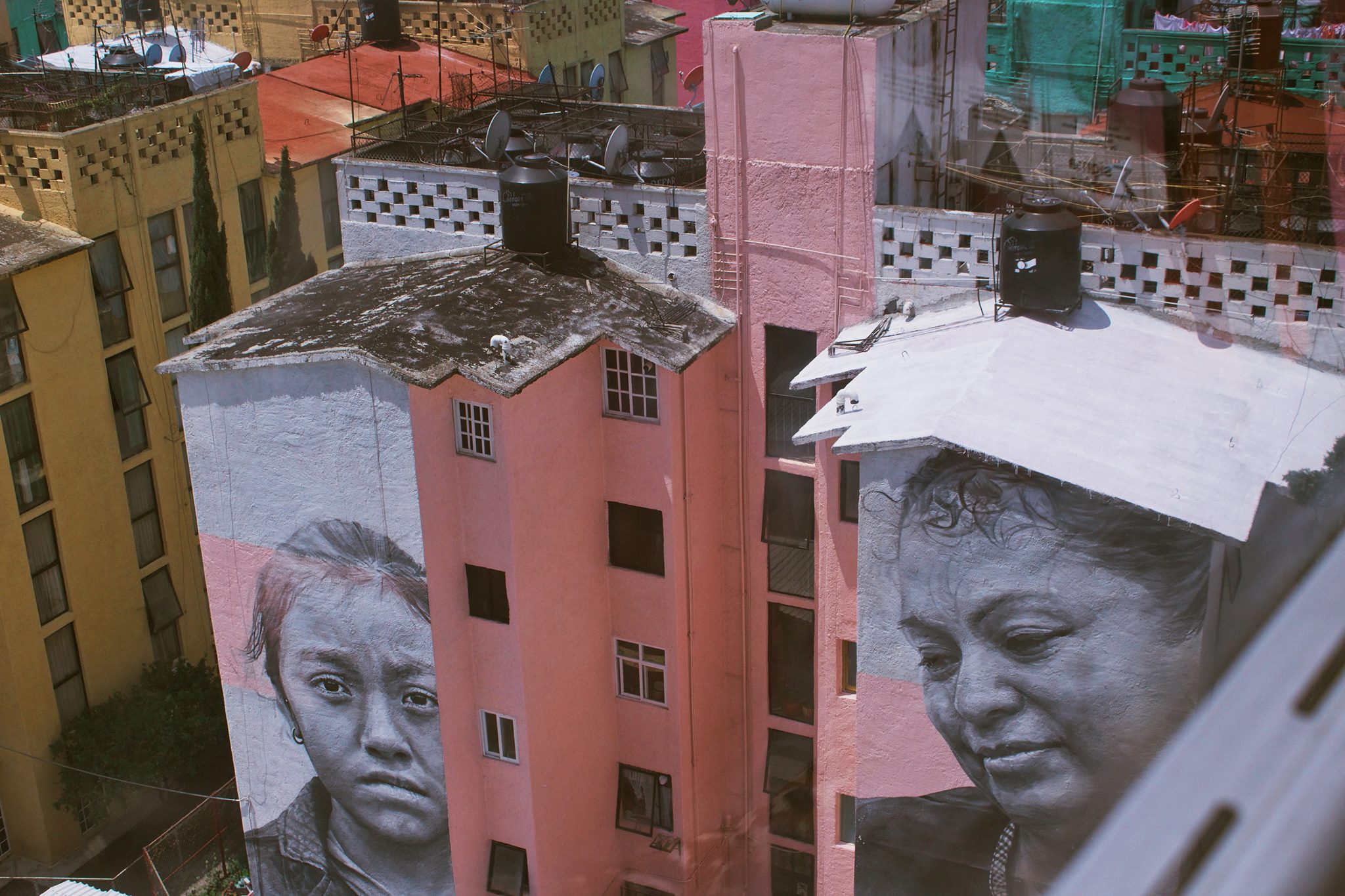

A view of Ecatepec city from Mexicable. (Photo by Nidia Bautista/Latino USA/NACLA)
At one point in Ecatepec, a city of two million people, ten times more women had been murdered than in Ciudad Juárez, the city in northern Mexico once considered the deadliest city in the world, where femicides drew international attention in the early 2000s. It’s a city where women’s bodies have been found in streets, empty lots, parks, and on public transit and stories of gruesome murders of women often shake the entire country.
Women Leading the Fight
Muciño says her work at the Women’s Justice Center in Ecatepec is an effort to help victims face the daunting task of petitioning for justice. She says that when her family started to prod the government’s investigation, they were completely alone. “We learned all that we know the hard way. Doors slammed in our face throughout these 13 years,” says Muciño. Women like Muciño are leading the fight against femicide in Ecatepec. They are women who have themselves sought help from official channels and have become activists in Ecatepec in the face of misogyny and sexism from government employees and men in their communities.
While there are state and federal laws on the books to address and stop violence against women, they are rarely if at all enforced. Between 2010 and 2011, only four percent of femicide cases resulted in sentences in the country. Of the 8,904 women killed in Mexico between 2014 and 2017, 1,420 occurred in Mexico State, and the majority of those were in Ecatepec. The majority of residents feel unsafe and many consider it the most dangerous municipality in all of Mexico. Grassroots groups have varying registers of femicide rates, but Muciño’s group says 168 femicides took place in the state in 2017, 21 of those in Ecatepec.
Muciño, who is familiar with dozens of femicide cases in the municipality, recalls the chilling details of Nadia’s murder based on her rigorous study of the investigation. Nadia’s husband, Bernardo Lopez Gutiérrez and his brother Isidro beat Nadia Muciño to death in front of her three children in Cuautitlán Izcalli. One afternoon the men and Nadia were in the house drinking beers when they threw her in a water tank, only to drag her into the bathroom and hang her there, according to Nadia’s youngest son’s testimony to officials. They altered the crime scene to make it look as if Nadia had hanged herself. But from the day they found Nadia’s body, Muciño’s family caught on to the public officials’ failure to conduct a thorough investigation. Forensic experts left the scene without the rope Nadia allegedly used to hang herself. The family found Bernardo’s shirt, which also somehow disappeared, stained with blood. The investigators didn’t take photos of the scene nor did they collect DNA evidence from Nadia’s body. Instead, a criminology expert from the state attorney general’s office determined that Nadia had committed suicide.
Bernardo’s brother Isidro was detained three years after Nadia’s murder after her children testified in municipal court. He was released in 2010 when the same group of judges disqualified the minors’ testimonies after ruling that the children were unable to distinguish the truth from fantasy. The family asked Mexico’s human rights commission for help, and together they denounced the Mexican government in front of the Interamerican Court for Human Rights. The court pressured Mexico for updates on the case, and in 2012 Bernardo was imprisoned. Though Bernardo was sent to prison for murder, the family wants Isidro detained and tried as well and the public officials involved in the investigation sanctioned for gross negligence.
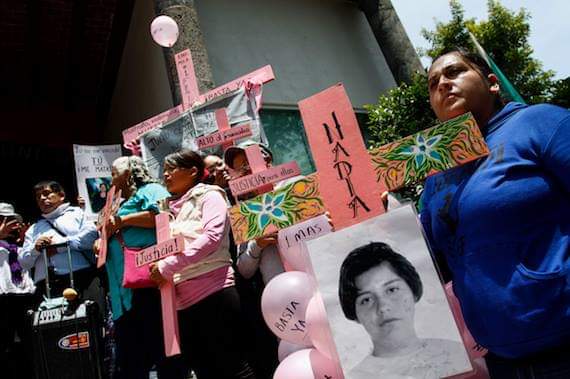

Viviana Muciño (front) works as a volunteer assisting women who have experienced gender violence in Ecatepec and their families. She says that everything she knows about femicide in Mexico is because of her sister’s murder. Her sister Nadia Alejandra Muciño Márquez was killed in 2004. (Photo by Viviana Muciño)
In October 2017, after 13 years of pressing the government for a fair and thorough investigation, Nadia’s husband Bernardo Lopez Gutiérrez was sentenced to 42 years of prison for homicide. The ruling falls short of her family’s hopes. They’re pressuring the court to rule the case as a femicide, adding 20 years to the sentence.
Gender violence is pervasive at the national level. In Mexico, more than half of all women have been victims of violence by men, either strangers or partners. Of Mexico’s 46.5 million women over 15-years-old, 66 percent have faced emotional, physical, sexual or economic violence in their lives while 43 percent have been abused by husbands or partners and 53 percent have faced violence perpetrated by strangers, according to Mexico’s National Institute of Statistics and Geography.
In 2007, Mexico passed a sweeping gender law that identified femicide as a crime and called for the creation of a national commission and policies to address it on the local and national level. The law,La Ley General de Acceso de las Mujeres a una Vida Libre de Violencia (The General Law for Women’s Access to a Violence-Free Life), made femicide a crime with a mandatory sentence of 20 to 60 years in prison.
Under this law, every murder of a woman must be investigated as a femicide. Though it is characterized by sexual violence and degrading injuries to victims’ bodies, femicide is defined as the violent death of a woman motivated by gender, whether it takes place within the family, domestic household or in any other interpersonal relationship, or within a community or by a stranger. The law also guarantees right to redress for victims’ relatives and establishes reparation measures like health care, psychological support and financial compensation. The law called for government officials to take a gendered perspective toward victims and created the Gender Alert, a set of government emergency actions to confront and eradicate femicide violence in a specific territory. And Ecatepec’s government created a Women’s Justice Center in 2016 to provide women with access to free legal assistance. Yet despite the progressiveness of these initiatives, cases like the murder of a young woman in a local meat shop in 2017 suggest that they fall short in addressing the violence.
Protest and Performance
Carolina Aguilar Navarrete, 20, grew up in Hank Gonzalez, one of the Ecatepec’s most dangerous neighborhoods. It is made up of brightly colored houses stacked atop rolling hills and sits west of the Pan-American highway that connects the city to Mexico’s capital. A year before graduating high school, Navarrete was almost kidnapped while walking with her father to school. A black van with tinted windows pulled up to them and men brandishing semi-automatic rifles attempted to drag her into the vehicle, which they gathered was full of kidnapped women. They escaped after a scuffle inside the van distracted the men. But she says the brush with the kidnappers made her feel extremely vulnerable in her neighborhood. “I was 16 years old at the time,” she says, “and it was completely a traumatic experience. I feared I would see that van again on my way to school. I lived everyday, my last year of high school, with fear.”
Today, Navarrete is a member of Invisibles Somos Visibles (Invisibles We are Visible), a collective that uses performance art to denounce femicide. The collective puts on performances throughout the state dramatizing the stories of local women who have been killed. Women, from Mexico State and Mexico City, take on the roles of women who were killed, making public and visible the violence they say is so often made invisible. They seek to generate discussion about machismo and misogyny within their communities and the legal impunity surrounding these crimes.
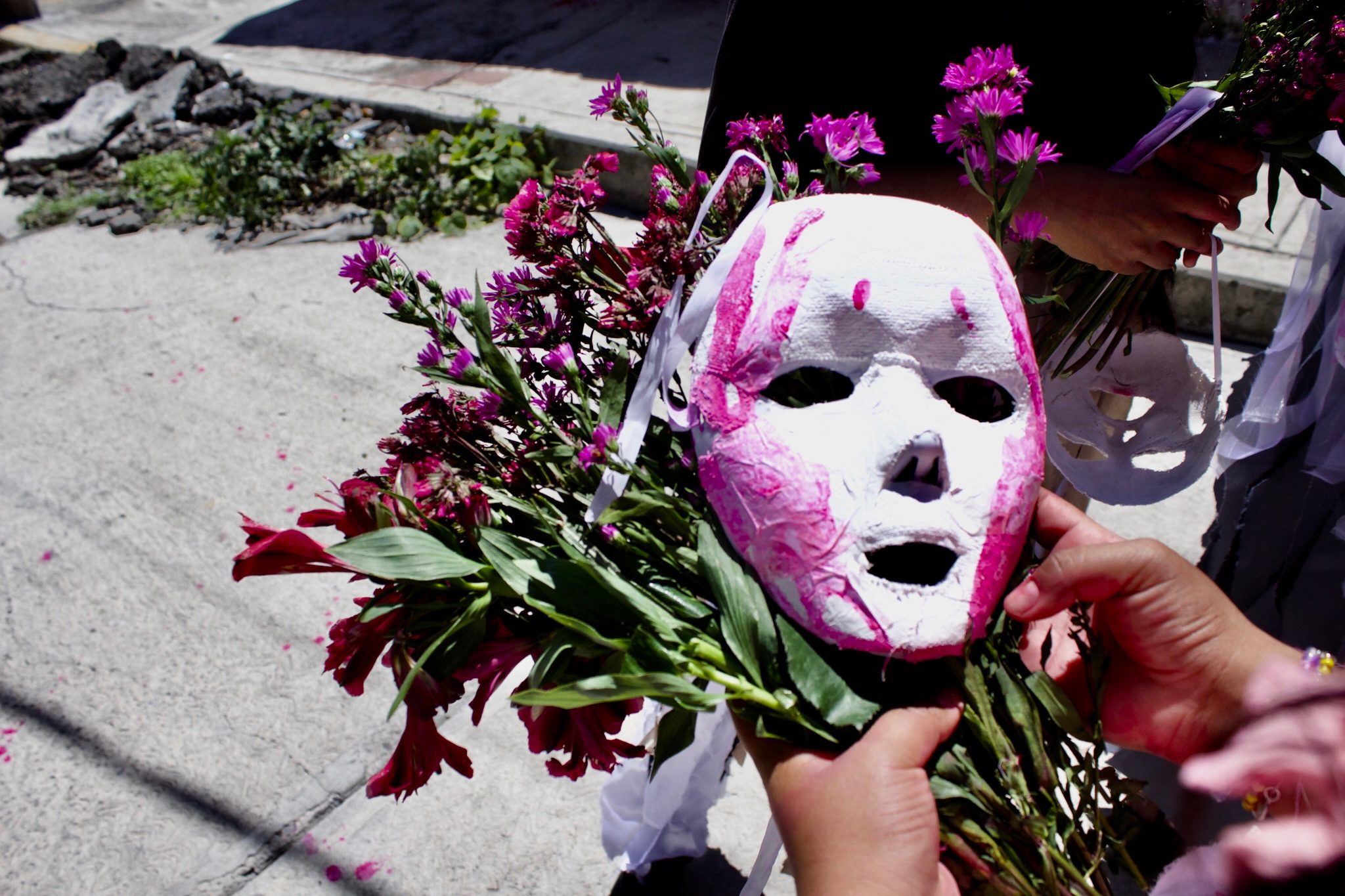

Papier-mâché masks and flowers from the Invisibles Somos Visibles performance in Colonia Ostor, Ecatepec. (Photo by Nidia Bautista/Latino USA/NACLA)
In July 2017, Invisibles Somos Visibles organized a protest against femicide in the Colonia Ostor neighborhood of Ecatepec, where in 2012, 14-year-old Jessica Lucero was raped and murdered. Two suspects were detained by authorities but only one, Giovani Loredo Soto, “El Salitres,” was sentenced to prison. Women arrived with white paper-mâché masks, crowns of pink flowers, and white dresses. Residents welcomed them. They’ve seen a great deal of crime throughout the years. In fact, Lucero’s former neighbors said they have discovered women’s bodies abandoned in a nearby overgrown and dried up river. With no assistance from the government, the neighbors decided to collaborate with the group to help teach their community about femicide.
Arranging themselves across the uneven pavement, each woman took turns sharing the stories of women who were slain in Ecatepec. Navarrete, a university student, says representing women who were murdered helps her confront the violence plaguing her community. “I feel as if I were that woman, who is often from my same neighborhood and my same age, but who left an unfinished life,” she says. “I relate to them because I remember my experience, if they had kidnapped me, if they had murdered me. When I represent them, I feel free to express what they could not. To help them be remembered over time.”
The prevalence of violence against women has sent ripples throughout the State of Mexico. Further west in Ecatepec’s colonia Las Americas, Mariana Joselín Baltierra stepped out of her house in July 2017 and walked 200 meters to buy groceries at a corner store. She walked past a local butcher shop, Carnicasa or meat shop, at around nine in the morning. She never returned home. Baltierra was found later that day lying dead across a butcher’s table, her stomach ripped open. She was raped and killed by a 28-year-old man who worked in the shop but escaped the scene of the crime and still remains at large.
Experts Weigh In
In Mexico City, activists like Maria de la Luz Estrada, who works with the National Citizen Observatory of Femicide, are monitoring the femicide crisis in Ecatepec, which led to the deaths of Mariana Baltierra, and so many others. The group consulted the Mexican government when it was designing its national gender law and the Gender Alert, a process Estrada says has been a constant battle. Women activists have had to pressure the Mexican government through conducting their own investigations and studies—as evidenced by the story of Nadia Muciño and her sister Viviana’s struggle for justice—while asking the government to do the same. They even partnered up with UN Women to pressure the Mexican government to share statistics on femicide.
The National Citizen Observatory of Femicide played an important role in defining femicide as a specific crime by pressuring the government to recognize an international court ruling in 2009. Even with the new laws, Estrada says the government does not prosecute perpetrators of femicide. “If it is not punished, if we do not detain them, it is an open invitation for more violence,” Estrada says. “If the husband kills his wife and you do not do anything to him, the government demonstrates a certain sanctioning of the violence.”
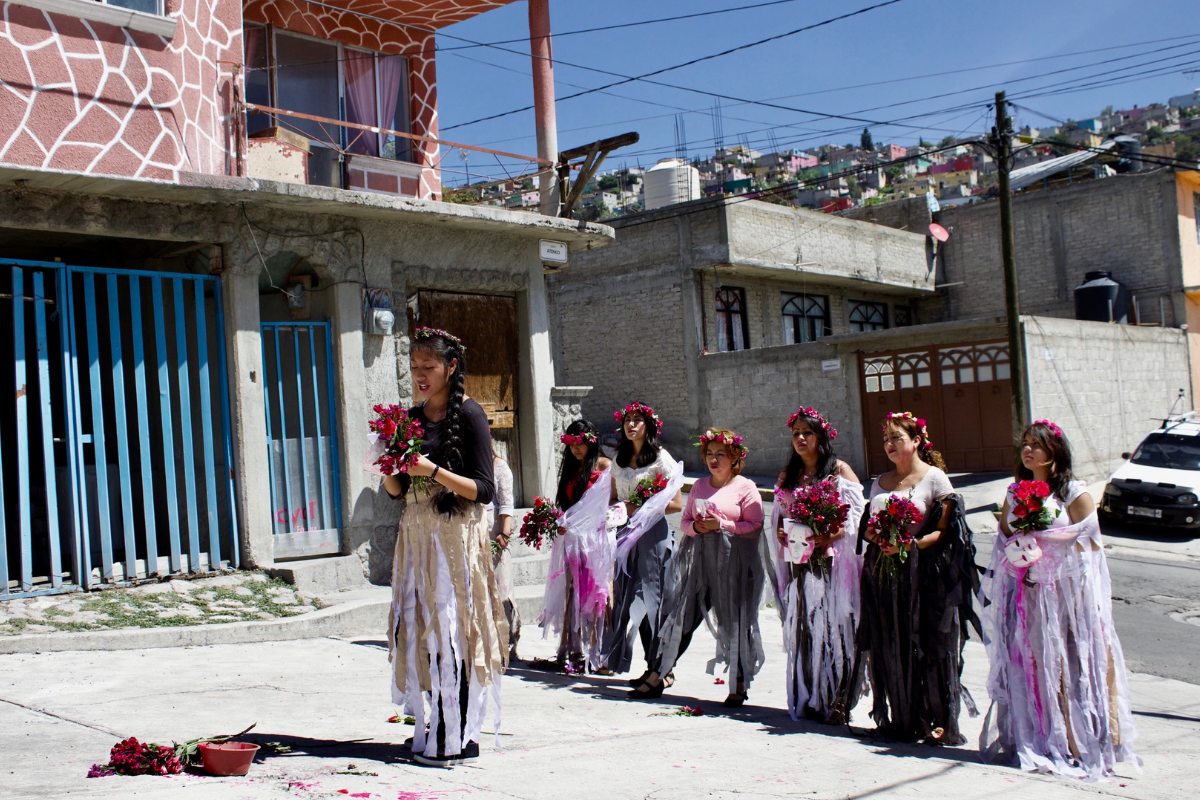

A shot from the “Invisibles Somos Visibles” group performance in Colonia Ostor, Ecatepec in July 2017. Carolina Aguilar Navarrete is front and center. (Photo by Nidia Bautista/Latino USA/NACLA)
Women human rights defenders are searching for ways to use the law to successfully prosecute cases, which means strategizing around making innovative legal arguments. Cynthia Galicio, a lawyer who was named the national expert in gender violence by Mexico’s National Institute for Women and assigned to the National Observatory for Gender Equality in 2015, says the issues that she and other gender experts confronted while trying to implement some of the mandates of the gender law remain rampant.
“In reality, femicide seems like a crime that is inevitable, like nothing can be done to stop it,” she says. “When you stop to think about what the government is failing to do, you realize that femicide can be deterred if the state does the following: protect, address and prevent. But they don’t protect women, they don’t address cases and they don’t prevent violence.”
Back in Viviana Muciño’s neighborhood in Nicolás Romero, news reports emerged in July 2017 about a family identifying the lifeless body of their relative riddled with knife wounds. Although she moved from their home in Cuautitlán Izcalli a few years ago to avoid the Gutiérrez family, Muciño’s family still live in the neighborhood and she says she often runs into Isidro, the brother and accomplice to her sister’s murderer, on the street. She says he taunts her, that his freedom is a reminder that justice has yet to be served.
Most days Muciño has to travel to the Women’s Justice Center and her other appointments by bus. She gathers some of the money she makes from sewing ball gowns and party decorations to pay for the trips. Unpaid and seemingly against great odds as an activist fighting gender violence and the corruption permeating Mexico’s institutions, Muciño says she has no choice but to continue.
“Long ago we decided that we are committed to this flight for the long haul,” she says. “For Nadia and because we cannot allow more men to get away with killing women.”
***
Nidia Bautista is a reporter covering migration and gender. Follow her on Twitter @nnmeli.


